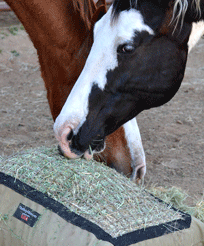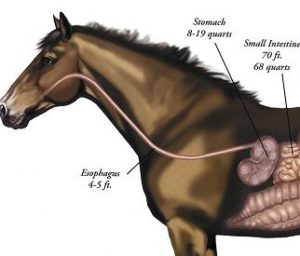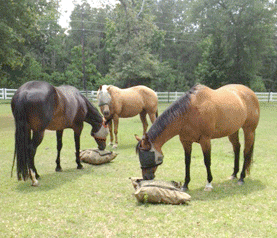 In this guest blog post, Monique Warren weighs in on some common issues with feeding and how slow-feeders like Hay Pillow can help. Warren writes:
In this guest blog post, Monique Warren weighs in on some common issues with feeding and how slow-feeders like Hay Pillow can help. Warren writes:
Some horses paw or are aggressive at feeding time, This is more than likely due to frustration and pain than actual behavior issues. They are anxious to “self-medicate” and they are not comfortable due to the build-up of acid or ulcers. They know as soon as they start chewing and eating it will start feeling better.
The equine stomach produces acid 24 hours a day in preparation for constant uptake and can empty in as little as 15-20 minutes. Chewing activates saliva production (saliva is an alkaline substance) which buffers gastric acid.
 Under natural conditions with free-choice forage, the horse will produce about five gallons of saliva every day and eventually “recycle” much of the water content via re-absorption prior to excretion.
Under natural conditions with free-choice forage, the horse will produce about five gallons of saliva every day and eventually “recycle” much of the water content via re-absorption prior to excretion.
They may also experience stress (which can cause ulcers) due to isolation; not experiencing physical interaction with other horses. Read more about Nature is Best notions here.
Feeding with slow feeders in multiple locations enables your entire herd to eat and live together full time. Equines are herd animals; they benefit physically and psychologically from direct physical interaction. Dominant members will keep the others moving as they claim various locations. The less dominant individuals nonetheless will have alternate sources to eat from; this encourages movement and can decrease cortisol levels associated  with stress from being physically separated from herd members.
with stress from being physically separated from herd members.
I have three very easier keeper Icelandic’s who have big appetites and potentially big bellies to match. I have used other slow feeders over the past 10 years, but have never had the success with truly slow feeding until I purchased Hay Pillows. It took them a few days to figure out their own technique for “grazing” with my youngest quickly figuring out that one hoof planted securely on edge of the pillow really worked. The other two learned from her example and all three have dramatically expanded the time that it takes to go through each hay feeding. I am particularly impressed to find that they are not nearly as angst for hay at early morning feed time, as they have been slowly eating throughout the night. Hay Pillows are a wonderful well made product that has made their lives and mine much less stressful. I have also found that their weight is much easier to regulate, as I know that each of them is getting their fair share of the hay with little or no waste. I will be purchasing additional pillows to allow them to have more options of areas to feed and will also make it very easy to prepare their hay in advance if I need to have someone do a feeding for me. It couldn’t be any easier even for those with little or no experience to just toss each one a pillow and watch the games begin!
As I understand it, hay pillows require the horse to be barefoot. My horses require front shoes… any hints?
HI Debbie,
We’ll send this along to Monique Warren. Stay tuned!